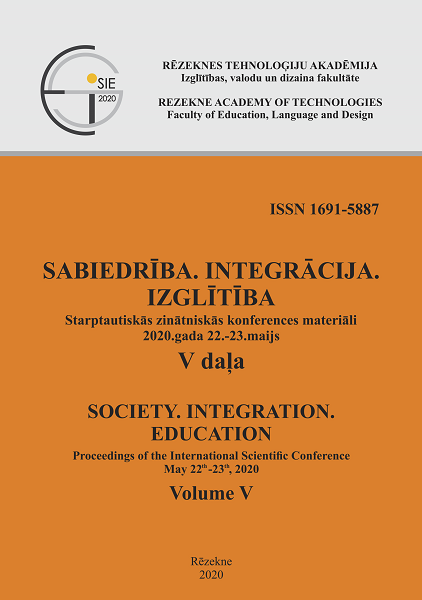PROGRESSIVE TECHNOLOGIES IN THE DESIGN OF OUTERWEAR REFLECTING ELEMENTS
DOI:
https://doi.org/10.17770/sie2020vol5.5013Keywords:
3D printing technology, experiments, reflective elements, laser cutting, nanotechnology, textile fabricAbstract
The purpose of this article is to substantiate the use of advanced technologies as a processing method of modern, versatile designing resources and environmentally friendly textiles, and to demonstrate their use in the design of light-reflective material elements in outerwear collections. Functional decorative solutions, using reflective materials, are topical in contemporary fashion design for the dark time of the day and can be realized using modern technology. Research methods: theoretical - literature; empirical - experiment and data processing. Period - 2018/2019. study year. The study is of practical importance as it demonstrates the impact of technological parameters on textiles. The availability of laser processing and 3D equipment at the Rezekne Academy of Technology provides opportunity for experimental work on different thickness, different fiber fabrics with a carbon dioxide laser system and different filaments for 3D printing, determining the optimum processing parameters for a particular type of cloth. As a result, the design of the collection is developed, providing the decorative and functional significance of the garments with reflective elements.
References
Almeida, L., & Ramos, D. (2017). Health and safety concerns of textiles with nanomaterials.
Akiwowo, K., Kane, F., Tyrer, J., Weaver , G., & Filarowski, A. (2015). Digital Laser-dyeing for Polyester Fabrics. Journal of Textile Design Research and Practice, 2(2), 133–151. Retrieved from
https://www.tandfonline.com/doi/abs/10.2752/205117814X14228978833457
Bukova-Žideļūna, A., Villerušas, A., & Pudule, I. (2018a). Atstarotāju lietošanas tendences Latvijas pieaugušo iedzīvotāju vidū. Retrieved from https://www.rsu.lv/sites/default/files/imce/Zin%C4%81tnes%20departaments/zinatniskas_konferences/2018/atstarotaju_lietosanas_tendences_latvijas_pieauguso_vidu.pdf
Bukova-Žideļūna, A., Villerušas, A., Pudule, I. (2018b). Latvijas pieaugušo iedzīvotāju ceļu satiksmes paradumu analīze. Skatīts 03.01.2017. Retrieved from https://rsu.lv/zinatniskie-raksti/latvijas-pieauguso-iedzivotaju-celu-satiksmes-paradumu-analize
Dubbert, W., Schwirn, K., Völker, D., & Apel, P. (2014). Use of nanomaterials in coatings. Retrieved from
Flynt, J. (2019). 3D Printing Fashion: Advantages, Disadvantages, and Future. Retrieved from https://3dinsider.com/3d-printing-fashion/
Holm, A., Jaani, J., Eensoo, D., & Piksööt, J. (2018). Pedestrian behaviour of 6th grade Estonian students: Implications of social factors and accident-prevention education at school. Transportation Research Part F: Traffic Psychology and Behaviour, 52, 112–119.
Hooijdonk, R. (2019). Wearing high-tech garments: smart clothes and nanotech fabric tailor the fashion of the future. Retrieved from https://richardvanhooijdonk.com/blog/en/wearing-high-tech-garments-smart-clothes-and-nanotech-fabric-tailor-the-fashion-of-the-future/
Is 3D printing a sustainable manufacturing method? (2018). Retrieved from https://www.3dnatives.com/en/3d-printing-sustainable-manufacturing-method-211120185/
Joshi, M. & Adak, B. (2019). Advances in Nanotechnology Based Functional, Smart and Intelligent Textiles: A Review. Comprehensive Nanoscience and Nanotechnology (Second Edition), 5, 253–290.
Lin, C.H. & Lin, C.M. (2013). The Study in the Application of Nanotechnology Digital Printing in Clothing Pattern Design. Retrieved from https://www.scientific.net/KEM.562-565.674
Lu, S., Mok, P. Y., & Jin, X (2017). A new design concept: 3D to 2D textile pattern design for garments. Computer-Aided Design, 89, 35–49.
Nanometres and nanoscale. (2014). Retrieved from https://www.sciencelearn.org.nz/resources/1651-nanometres-and-nanoscale
Nayak, R., Nguyen, L., V., T., Panwar, T., & Jajpura, L. (2020). Sustainable technologies and processes adapted by fashion brands. Sustainable Technologies for Fashion and Textiles, 233-248.
Phelps, N. (2019). Fall 2019 CoutureIris van Herpen. Retrieved from https://www.vogue.com/fashion-shows/fall-2019-couture/iris-van-herpen
PROGRESĪVS definīcija Latviešu valodā. (2019). Latvian Oxford living dictionaries. Retrieved from https://lv.oxforddictionaries.com/skaidrojums/progresivs
Reed, R., Zaikova, T., Barber, A., Simonich, M., Lankone, R., Marco, M. et al. (2016). Potential Environmental Impacts and Antimicrobial Efficacy of Silver and Nanosilver-Containing Textiles. Retrieved from
https://www.sciencedaily.com/releases/2016/03/160330122634.htm
Richardot, A. (2018). 3D printed fashion: Why is additive manufacturing interesting for fashion? Retrieved from https://www.sculpteo.com/blog/2018/01/24/3d-printed-fashion-why-is-additive-manufacturing-interesting-for-fashion/
Salman, S. (2016). Nanotechnology in textile. Retrieved from https://www.slideshare.net/ssalman69/nanotechnology-in-textile
Shahrubudin, N., Lee, T.C., & Ramlan R. (2019). An Overview on 3D Printing Technology: Technological, Materials, and Applications. Procedia Manufacturing, 35, 1286–1296.
Song, L. (2019). Sandra Hocevar wins the NanoImpact & NanoTox best poster Award 2018. Retrieved from https://www.journals.elsevier.com/nanoimpact/news/sandra-hocevar-wins-the-nanoimpact-nanotox-best-poster-award
Stepanov, A., Manninen, M., Pärnänen, I.,Hirvimäki, M., & Salminen, A. (2015). Laser Cutting of Leather: Tool for Industry or Designers? Physics Procedia, 78, 157–162.
Technology will influence fashion (2000). USA Today Magazine, 129(2666), 2–8.
Tessier, D. (2013). Surface modification of biotextiles for medical applications.
Vilumsone-Nemes, I. (2018). Industrial Cutting of Textile Materials (Second Edition).
What is nanotechnology? (n.d.). Retrieved from https://www.nano.gov/nanotech-101/what/definition
What is 3 D printing. (2019). Retrieved from https://3dprinting.com/what-is-3d-printing/






